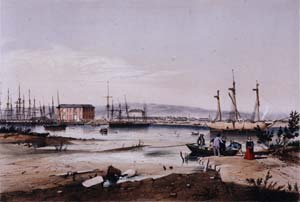
Foundation of South Australia 1800-1851 - Key events and issues
The Foundation of South Australia 1800-1851 explores and illustrates the pioneering phase in South Australia, and showcases the themes of exploration, emigration, early contacts with Aboriginal Australian people and their families, and the establishment of a colony.
Click on the items below to explore early resources, including first-hand accounts in settlers' diaries and letters, artistic impressions of early Adelaide, maps, and records from the papers of William Light and the South Australian Company, settlers, pioneers... and more.
In the early 1800s, Baudin in Le Geographe and Freycinet in Le Casuarina explored Kangaroo Island and the South Australian coastline, recording French place names for various locations. Kangaroo Island's west and south coasts became occupied by American sealers, escaped convicts and runaway sailors. A Voyage to Terra Australis, the account of the English expedition under Matthew Flinders which included investigation of the 'unknown southern coast', was published in 1814. In By 1819 George Sutherland had spent several months on Kangaroo Island collecting a cargo of seal and kangaroo skins and positively reporting back to England which prompted the South Australian Company to select Kingscote for its first depot in the new province in 1836.
Charles Sturt's expedition (1829-1830) from New South Wales traced the Murrumbidgee River to its junction with the River Murray, and then followed the Murray downstream to reach Encounter Bay in February 1830. By 1833, the South Australian Association was formed in England by Robert Gouger, in order to found a colony on the principles of Edward Gibbon Wakefield's 'system of colonization'. In the following year, the establishment of South Australia was made possible when the South Australian Colonization Act (UK) received Royal Assent. In contrast to other Australian colonies, South Australia was to be a planned colony without convicts, to be administered by Colonization Commissioners and the Colonial Office. In the same year, Captain John Hindmarsh was appointed the first Governor of South Australia, and the South Australian Company established, chaired by George Fife Angas.
William Light was appointed Surveyor-General in 1836 and the first migrant ships left England for South Australia, with the Duke of York, Lady Mary Pelham and John Pirie some of the first to arrive at Kangaroo Island. Colonel William Light arrived at Kangaroo Island aboard the Rapid to examine and survey coastal and inland areas for the location of a capital city. He later reported Adelaide and the Port Creek as most suitable and surveyed one acre blocks, surrounded by designated Park Lands. By October of the same year, settlers had arrived at Holdfast Bay aboard the Africaine and the Buffalo, including the Thomas family who would print the first newspaper in South Australia, and Governor John Hindmarsh who would proclaim the South Australian government to be operational, with laws to be in effect and Aboriginal people be under the safeguard of those laws. Two whaling stations were established at Encounter Bay and J.B. Hack planted South Australia's first vines.
By the 1840s, Eyre explored the Eyre Peninsula region and the northern interior and Charles Bonney brought stock overland from the Port Philip District to Adelaide via Mount Gambier and the Coorong through South Australia's South-East. There was more building, including the first bridge over the River Torrens and the road from Adelaide to Port Adelaide. The mouth of the River Murray was surveyed by Pullen and Adelaide's first mayor, James Hurtle Fisher was elected. By 1841 Adelaide had its own hospital, which would become the Royal Adelaide Hospital (1939) and the Queen's Theatre on Gilles Street had its first performance (Othello). Mining started up at Glen Osmond and Kapunda, along with the establishment of the Savings Bank of South Australia and the Adelaide Gaol. Pastoral land was now able to be held with occupation licenses (which were replaced in 1851 with 14 year leases) and John Ridley invented a machine to better reap and thresh wheat. 1844 saw the opening of a school for Aboriginal children at Walkerville, Aboriginal people were allowed to give evidence in court and Aboriginal children were apprenticed to work under the guardianship of the Protector of Aborigines.
Wine production featured post 1844. Walter Duffield made what was possibly the first South Australian wine. German-born Johann Gramp established the first commercial winery in the Barossa Valley at Jacob's Creek and Joseph Gilbert started Pewsey Vale winery in the neighbouring Eden Valley. By 1851 JE Seppelt had established his vineyard near Tanunda. 1846 saw explorers move further with John Horrocks traveling north from his station near Clare by camel, with artist ST Gill and party. In 1849 and the Beehive corner was established as a drapery store and by the mid 1850s, pastoral leases extended to the northern Flinders Ranges, with some located at tips of Yorke and Eyre Peninsulas, and almost half the colony's population had settled in Adelaide city and nearby Adelaide Plains.
By 1850, copper had been discovered at Burra Burra, explorers had penetrated further inland, the Savings Bank of South Australia was established and the Australian Colonies Government Act was passed by British Parliament, enabling a Legislative Council with 24 members in South Australia, with 16 to be elected and 8 appointed by the governor.
South Australiana: Sources a comprehensive list of websites, published and non-published sources for South Australiana materials.
Please see the SA Memory Timeline for other significant events in South Australia, up to 1851. Load the Timeline and select 1840s and 1850s.
Items 1 - 12 of 58














